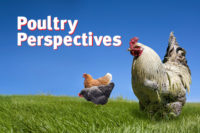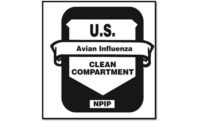One factor that makes Salmonellacontrol so difficult is its many potential sources. Salmonellais a very common bacterium in the intestinal tracts of many types of animals and can be easily transmitted to other animals. Salmonellacan be introduced into a poultry flock by rodents, insects, dogs, cats, people, feed ingredients, other birds and many other sources. Some types of Salmonellacan also be transmitted through eggs to the next generation of chickens or turkeys.
A second factor that complicates Salmonella control is that there are so many types. Salmonellais a very large family of bacteria with tremendous variation within the group. As one type of Salmonellais eliminated from a poultry production system, it is commonly replaced by a different type of Salmonellathat gets inadvertently introduced into the system. Effective vaccination to prevent Salmonellain poultry flocks is difficult because each type of Salmonellain a poultry flock must be targeted by a vaccine specific for that type of Salmonella.
Another important consideration for understanding Salmonella control in poultry is that very few Salmonella types cause disease in poultry. The Salmonella types that actually cause disease in poultry have been eliminated from commercial poultry production. Most Salmonellatypes simply inhabit the intestinal tracts of chickens and turkeys without causing any harm. However, many of those same Salmonellatypes, which cause no problem to poultry, will cause illness in humans if transmitted to them by poultry products. Because there are typically no signs of Salmonellain a poultry flock, detection of Salmonellain flocks requires sophisticated culture and detection techniques to find theSalmonellaand then determine its type. Salmonellacan be difficult to quickly detect and its source can be difficult to determine. This provides an additional level of uncertainty and difficulty to Salmonellacontrol programs.
Despite the hurdles to effective Salmonella control in poultry, tremendous progress has been achieved in the reduction of Salmonella in commercial poultry production and poultry products in the United States. Salmonella pullorum and Salmonella gallinarum, two types of Salmonella that do cause disease in poultry, have been eliminated from commercial poultry in the U.S. through a voluntary control program administered by the National Poultry Improvement Plan (NPIP). The NPIP has also been instrumental in the very successful reduction of Salmonella enteriditis, which causes disease in people, from breeding flocks in the U.S. The incidence of Salmonella contamination of poultry meat products has been on a steady decline over the past several years because of interventions that companies have taken in the live production phase, as well as the slaughter and processing phases of poultry production. The incidence of Salmonella contamination of table eggs has also been drastically reduced.
Research has been an important driver of these Salmonellacontrol successes. All of the interventions now used in the poultry industry came about from the application of knowledge gained, and techniques developed, from focused research. The U.S. Poultry & Egg Association (USPOULTRY) research program has invested millions of dollars toward funding research forSalmonellacontrol and continues to do so. Just recently, USPOULTRY and the USPOULTRY Foundation allocated additional funds targeting research to find ways to further reduce Salmonellalevels on processed poultry products, ground poultry products and table eggs.
Although the challenge to reduce Salmonella levels has been difficult for the poultry industry, the successes are impressive. New research will help the industry learn even better ways to reduce Salmonella and meet the needs of the consumer for safe, wholesome poultry products.
Dr. John Glisson, DVM, MAM, Ph.D., is director of Research Programs for the U.S. Poultry & Egg Association.



